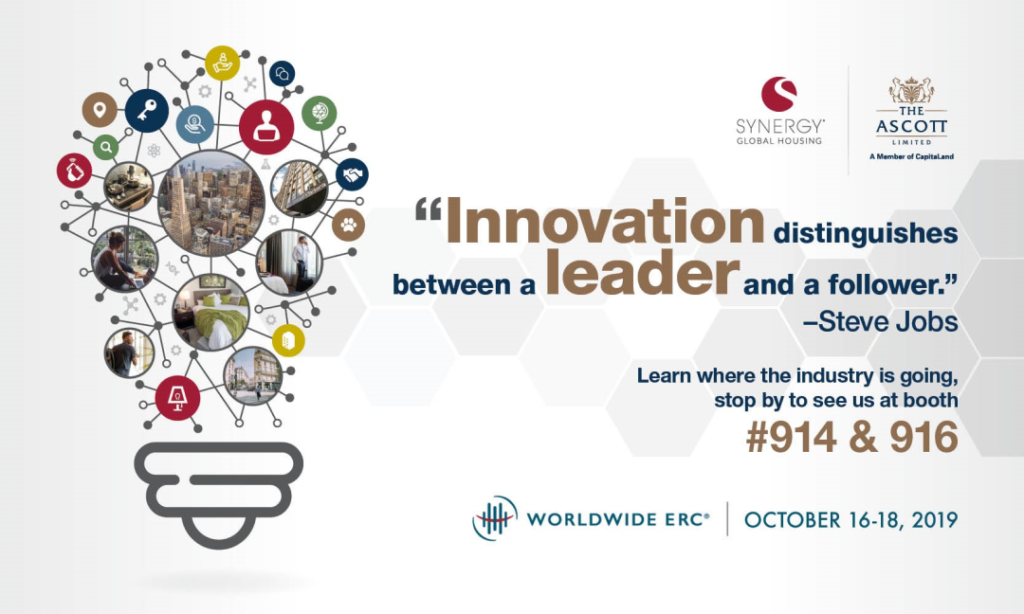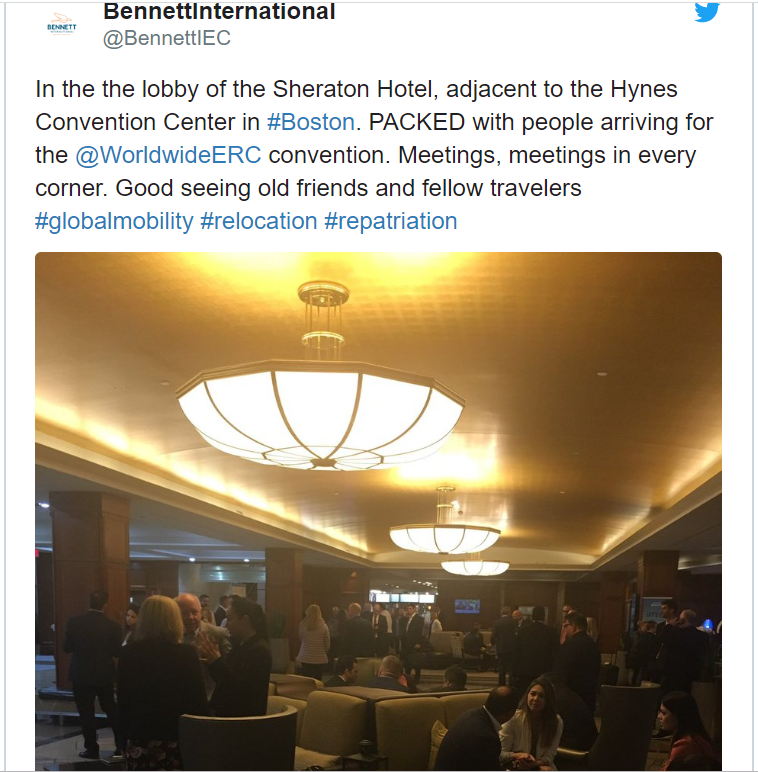A Guide to the Major Takeaways You May Have Missed… While Stuck in a Meeting
Global conferences are a lot like visiting family during the holidays. You usually travel to get there. You feel a bit of anticipation leading into the event as you get everything prepped and ready. Once you finally get there, you can sense the energy in the air and it fills you with a bit of optimism. You tell yourself how great it will be to see Aunt Jane or discuss that potential partnership with that vendor. Then it’s like speed dating.
And without fail, by the end, either holidays with the relatives or a worldwide conference, you are half sprinting through the lobby with a hat over your eyes, rushing to catch the early flight, fingers crossed you don’t see another familiar face until you get home to your four-legged buddy.
But those darn meetings are necessary, right!
Going into Worldwide ERC Boston two weeks ago, the Synergy team was excited. Our booth was locked and ready to go. Our theme was innovative, literally.

Yet in typical fashion, my time was overrun by meeting after meeting, a fate I have come to find out, many attendees experienced. That left me wondering what I missed on the tradeshow floor and during the breakout sessions. Assuming I wasn’t the only one who felt this way, I reached out to a few fellow attendees and asked them for their biggest takeaways from Worldwide ERC, Boston. Based on their feedback, I put together a top-five list.
Networking and Partnerships Are Vital to the Health of Our Industry

Not to keep slurping the straw of an empty drink, but this Tweet from Bennett International sums up my time in Boston perfectly. Meetings in every corner of my life.

As noted above, meetings were happening left and right, early morning, late morning, early lunch, happy hour, evening drinks, dinner, and the kicker, the late-night “fun” meetings that just made the next early morning meeting that much more fun.
While these meetings can feel like an annoyance as your productive-mind is freaking out, in actuality these meetings are the melting pot where strategic partnerships and alliances blossom. The networking and endless exchange of business cards drive brand awareness and unlock dynamic potential for what we can all offer each other. I think this fosters a more transparent landscape, and as a result, create smart, profitable partnerships.

At the end of the day, this is great for the guest and even better for the client because it prunes away hallow business models and the price wars inherent in multi-layered competing service environments. Ultimately, meetings create coherence amongst service providers allowing the guest-experience the space it needs to win the day.
Lump-Sum

Is this trend heating up, or cooling down? Lots and lots of talk surrounded this hot-button topic. The growing popularity of lump-sum seems to be in response to dynamic digital platforms that offer heighten visibility and access to available inventory. Property owners are now seeing the opportunity to transfer their sitting inventory into bookable units, and more and more platforms are popping up promising to deliver a one-of-a-kind product experience. To add to that, more and more corporations use the promise of a preferred business travel experience to attract top talent to their organizations leveraging the perception and allure of the high-visibility digital platforms.
Optionality is excellent for the industry as it elevates our overall product standards, which in turn is great for the guest. However, organizations still have a level of responsibility to the business traveler that goes beyond merely handing out reimbursement checks—namely, safety, security, and duty of care. Corporations need to understand the liability relevant in the face of accidents and injuries to their employees staying off-site at unknown, undisclosed locations. On the business front, how do corporations ensure employees can focus during a stressful move? We all know, no two relocations are the same.

The takeaway from this trend is multi-faceted. On the one hand, corporations need to be mindful of the risks associated with lump-sum travel while providers need to adjust and find a way to give their offerings more visibility. Furthermore, as our industry adapts to cater to this growing pool of business travelers—those who prefer to manage their own travel and expect an elevated experience in line with that of leisure travel—providers need to protect the guest experience from the growing pains of the pursuit to be front and center during the search process.
Experience dictates, attracting eyeballs, and booking units is just the tip of the iceberg in the overall product experience of a business traveler. Guest service, intuitive smart communication and resources, in-unit amenities, modern-day comforts, community amenities, and reimbursement services are just a few of the less-sexy components of mobility, assignments and business travel deserving just as much attention as the presentation of inventory options and securing social worthy product partnerships.
Disruptors

Unsurprisingly so, I had many conversations and overheard even more about industry disruption. Anyone maintaining a mellow pulse on the industry is aware of the emergence of new technology-driven startups. Whether it is new providers or new services and products from existing providers, it is evident that the industry is growing in scope and scale.
Now, if providers labeled disruptors are good or bad for the industry, or if their business plans are sustainable is something for the future to behold. Still, one doesn’t need to be able to read tea leaves to see the massive potential awaiting those who get it right.
I think it is safe to say competition is good for the industry as it forces everyone to stay laser-focused on what matters most. The question is… what matters most to you? Providers who focus solely on property and customer acquisition are missing a significant element of the equation, while those who remain static in their current methods of attracting clients and guests will fall behind with vacant inventory.
Our industry may have shallow entry points. That said, success sits at a much higher benchmark. Getting it right and being successful involves many layers of interlocking features and services, all of which need to work together to serve the most crucial part of the equation, the guest.

Having a built-in process to help understand the needs and wants of the client and guest is a must as the industry evolves. Yet that is just the first step towards solvency. Maintaining the willingness, flexibility, and resources to adapt core processes and technology to not only meet but answer the evolving demands will be critical to the success of the next generation of serviced accommodation providers.
Innovation/Technology
Is all innovation technology? Or is all technology innovation? Riddle me that! Either way, you feel about my riddle, a major theme in Boston centered around how companies are innovating using technology.

Let’s take Synergy, for instance. Our whole theme this year was innovation, artfully coined Innovation Labs. At our booth, we outlined how, using virtual reality and 3D imagery, we are giving guests the ability to take an immersive tour of their future space before they book a property. We highlighted our brand-new collaborative living product, SynergySpaces, a product aimed at alleviating tight supply in high-density markets. We showed off our new instant booking capabilities, and lastly, we showcased how we are putting data to work for our partnerships through predictive analysis to help drive more considerable cost savings for our clients. Plug achieved!
But in all seriousness, while not all innovation requires technology, a majority nowadays revolves around how providers are using technology to elevate the guest experience. If it is on the front-end in procurement and fulfillment, or during the stay with guest services, communication, and amenities, or on the back-end in terms of offering a seamless handoff between complementary services providers. Bottom line, there are numerous solutions available to help usher the industry into a digital-friendly landscape. One that mirrors the everyday conveniences and expected user journey of the mobile and digital world we live in.

While one might call this table stakes in 2020, providers who can build in an agile framework with a focus on connectivity, stand the most to gain as Millennials and Gen Z flood the marketplace. Bridging on my first takeaway, partnerships pave the way for the best guest experience. I believe companies need to think beyond how the technology works for them and start looking at how their technology makes them a better partner and in turn, a better overall solutions provider.
Cultural Awareness
Globalization is a reality in today’s business world. Trade, commerce, and travel have transcended borders and created many multinational organizations. As a result, business leaders and specialists are called to travel more than ever before. Business travel ranges from quick weekly stints to long, two-year, fully immersive experiences.

Many discussions happened around how best to deal with the inter-mingling of leaders and specialists from around the world. Heavy conversations revolved around how-to best welcome guests from other cultures, what to do to maintain cultural sensitivity, creating safe spaces, suspending judgment, to name a few of the more salient concepts I heard. While all is fantastic advice, it seemed to frame the proper approach to Cultural Awareness as a need, whereas I like to think of it as an opportunity.

Instead of focusing on the differences, let us focus on the common bonds we all share and value, which drives me back to hospitality and the desire to take care of people visiting. The takeaway here is simple; remember who owns the burden of service in the relationship between guest and host. Fundamental to a service-first philosophy is one’s ability to keep things as simple as possible to stay laser-focused on what truly matters.
How Was Your Trip?
I find it fun to come home from a long exhausting trip and partake in a download with my spouse. The complete and utter lack of context (beyond the day-to-day venting, of course), provides an elegant restraint in the way I share the story. Aside from the mundane back-and-forth about the amazing food you expensed and the flat hotel pillows, what they really want to know is the reason why you needed to be away. You are then forced to dig beneath that initial layer of fatigue and the gut reactions to all the craziness (“holy smokes, the meetings!”) and ask yourself why you just spent a week away from the ones you love.
This time around, answering that question filled me with a sense of pride, or more likely, the feeling of vindication because I had a great answer.
Hospitality is either in your blood or not. The opportunity to help a guest feel at home in a foreign, stressful environment either tugs at a passion or not. Now it is one thing for individuals of an organization to feel this way, but for an organization to make it a part of its processes and internal culture is entirely different. When organizations get it right, every employee up-and-down the organizational ladder feels empowered and encouraged to make every guest feel safe, secure, and comfortable—essentially at “home”—in their serviced accommodation. Organizations that get that right don’t need to worry about missing meetings, lump sum, disruptors, or cultural awareness because an exceptional guest experience solves it all.
While hospitality isn’t a truly novel concept or something you can code into an app, it is something to keep in mind as our industry evolves into a new era of service potential. That is my major takeaway, and what I told my spouse I spent my time doing in Boston.






